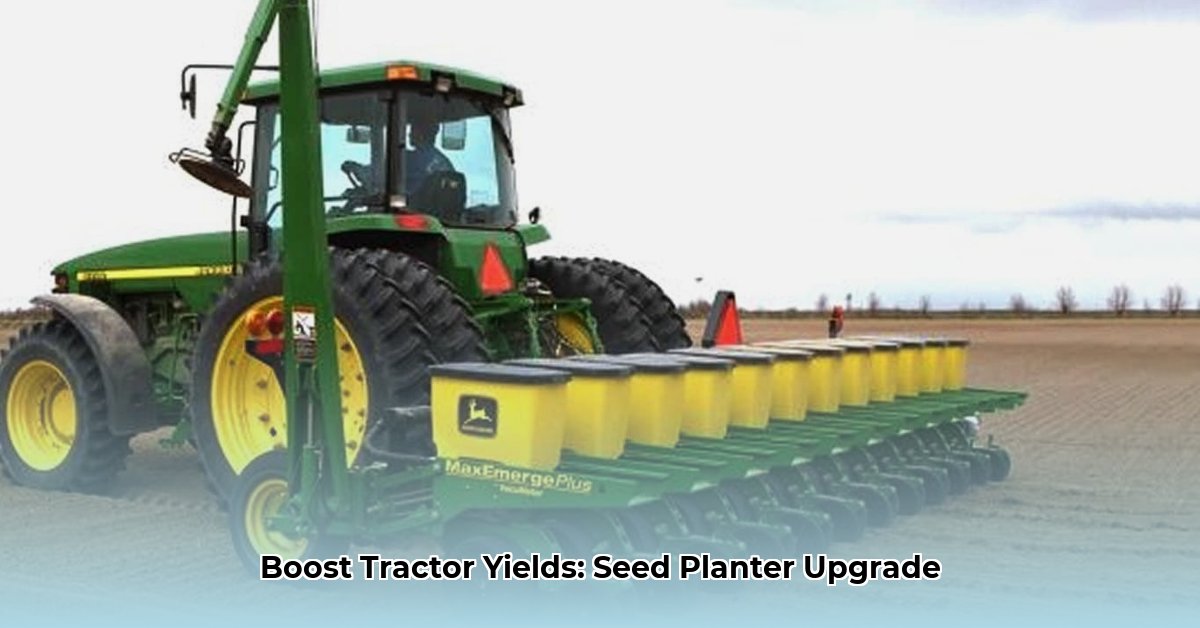
Ready to boost your farm's productivity and profitability? Upgrading your tractor's seed planter is a game-changer, offering smarter farming practices that lead to increased yields and a more sustainable operation. This guide walks you through selecting the right planter, understanding its technical aspects, and maximizing its benefits for both your bottom line and the environment. For more information on tractor implements, check out this helpful resource.
Types of Seed Planters for Tractors: Finding the Right Fit
Choosing the right seed planter is crucial; it's like selecting the right tool for a specific task. Several types exist, each with unique advantages and disadvantages.
Air Seeders: These planters use airflow to distribute seeds, ideal for large fields and diverse crops. However, accuracy may suffer with smaller seeds, leading to uneven spacing. They are typically used in large-scale operations.
Precision Planters: These high-tech machines offer pinpoint seed placement, maximizing yield and minimizing waste. While the initial investment is higher, the long-term benefits (reduced seed waste, improved plant health, and increased yields) often outweigh the cost.
Row-Crop Planters: Designed for crops planted in rows (like corn or soybeans), these planters often include integrated fertilizer placement for enhanced nutrient delivery. Their efficiency and reliability make them a common choice.
No-Till Planters: These planters are designed for direct seeding into undisturbed soil, minimizing soil disturbance, and promoting healthier soil ecosystems. This is a core practice in sustainable agriculture.
The best planter depends on your farm size, soil type, crops, and budget. A smaller operation might find a general-purpose planter sufficient, while a large-scale operation benefits from a high-tech model. Isn't it time to consider which planter best suits your needs?
Key Technical Features: Understanding the Inner Workings
Let's delve into the technical aspects that drive these machines' performance. Several key features significantly impact a planter's effectiveness.
Seed Metering: This system ensures consistent seed spacing, a critical factor for even plant growth and maximizing yields. Inconsistent spacing leads to uneven growth and reduced profitability.
Depth Control: Maintaining consistent planting depth is vital for seed germination and seedling vigor. Variations hinder emergence and plant health. A robust depth control system is essential.
Row Spacing Adjustment: The distance between rows impacts plant density and competition for resources. Optimizing row spacing maximizes plant growth and yields.
GPS Integration: GPS-guided planters enhance planting precision, minimizing overlaps and maximizing efficiency. GPS technology reduces human error and improves resource management. How much time and resources could you save with GPS integration?
Choosing the Right Seed Planter: A Step-by-Step Guide
Selecting the right planter requires careful consideration. This step-by-step guide ensures you make an informed decision.
Assess Your Needs: Consider your crops, field size, and budget before researching models. Determining these factors is crucial.
Research Different Models: Explore various manufacturers, compare models, and check reviews from other farmers. Online resources and conversations with fellow farmers are highly valuable.
Consider Your Soil Type: Planters perform differently in various soil types. A planter effective in sandy soil might struggle in clay. Soil type is a critical decision-making factor.
Demo Different Options (If Possible): If your budget allows, demo a few models. Hands-on experience provides invaluable insights beyond online reviews. What will be the best way to demo different options?
Maintenance and Operation: Ensuring Long-Term Performance
Regular maintenance is crucial for optimal planter performance, much like routine maintenance on a vehicle. Consider prevention over the costly process of repair.
Pre-Season Checks: Before planting season, conduct a thorough inspection. Check for damage, lubricate parts, and replace worn-out components. This ensures your planter is ready for peak performance.
Regular Calibration: Regular calibration is essential for consistent seed spacing and planting depth. Consistency safeguards your investment and ensures optimal results.
Troubleshooting: Familiarize yourself with common issues and solutions. Prompt troubleshooting prevents minor problems from escalating into major issues.
Sustainability and Economic Benefits: Beyond the Numbers
Precision planting offers significant sustainability advantages, improving profitability while reducing your environmental impact.
| Benefit | Detailed Explanation |
|---|---|
| Reduced Seed Waste | Accurate placement uses only the needed amount, minimizing waste. |
| Optimized Fertilizer Use | Precise placement targets nutrients where needed, reducing excess. |
| Improved Water Management | Efficient water use thanks to improved germination and spacing. |
| Reduced Soil Erosion | Minimal soil disturbance preserves topsoil and reduces erosion. |
Beyond environmental benefits, you'll see reduced fuel consumption, lower labor costs, and increased yields, leading to a higher return on investment. "Precision planting represents a paradigm shift in how we approach agriculture, allowing us to increase efficiency while minimizing our impact on the environment," says Dr. Anya Sharma, Agricultural Engineer, Purdue University.
Conclusion: Investing in Your Farm's Future
Upgrading your seed planter offers compelling advantages. The initial investment is offset by long-term gains in efficiency, sustainability, and profitability. It's a smart investment in your farm's future and a step towards a more productive and environmentally responsible operation. Are you ready to make that investment?